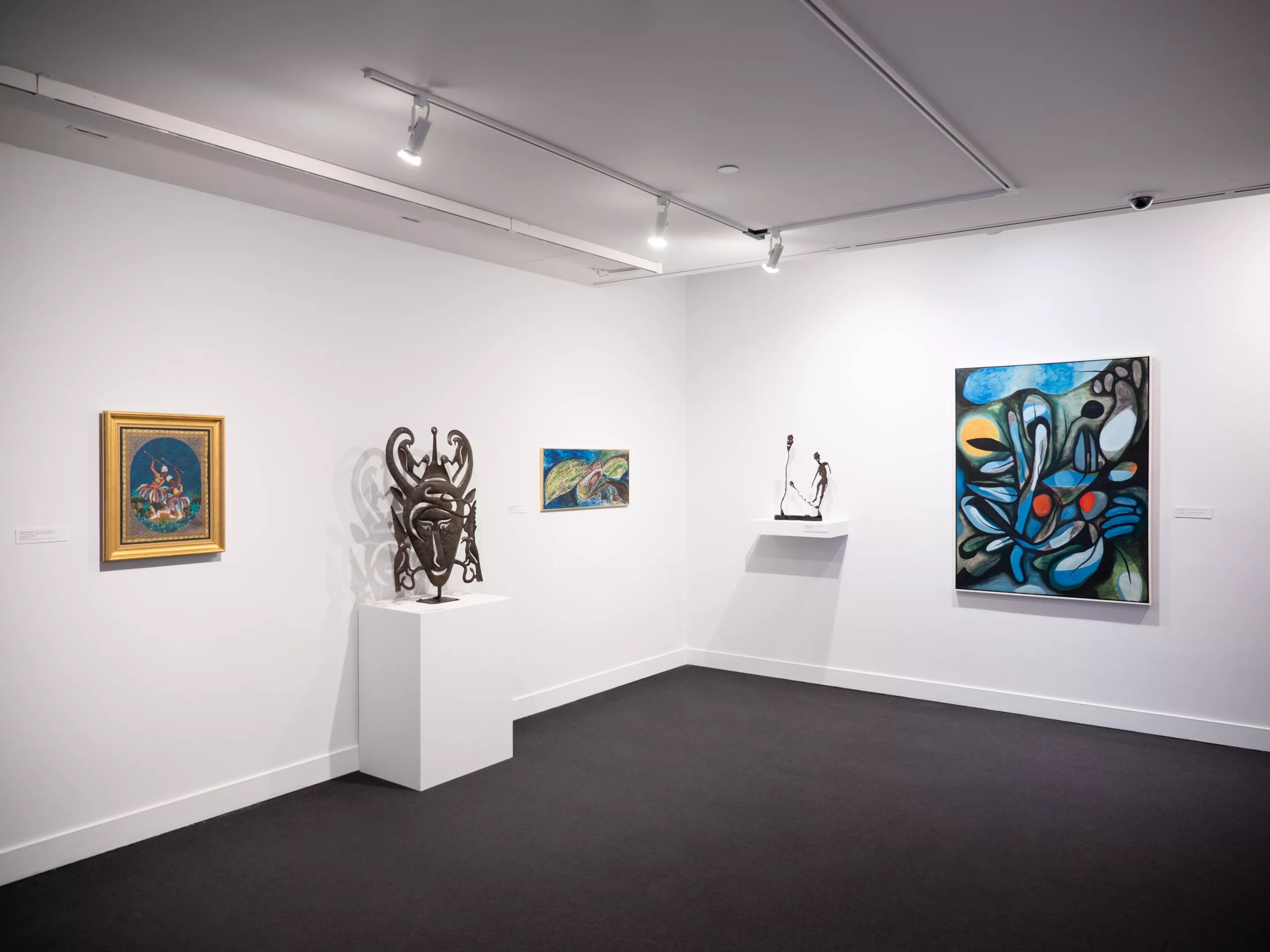
NSU Art Museum photo

Audio By Carbonatix
One of the central artworks in “Cosmic Mirrors,” NSU Art Museum’s latest exhibition highlighting Haitian art, is an image out of a dream. La Métamorphose d’Erzulie, a 1996 work by self-taught artist Frantz Zéphirin, is a rhapsody in blue, with dozens of animal figures swirling around a central icon of Erzulie Fréda, a vodou spirit representing love and beauty. It’s an image that’s hard not to compare with European antecedents, most obviously Botticelli’s Birth of Venus. Although thematically similar, Zéphiri’s work is wholly original, a vision the artist, a Vodou priest, says came to him in a dream.
“One day when I was sleeping by the sea, a mistress, Erzulie Fréda, appeared and said to me: I will show you how to paint me,” Zéphirin relates in the wall text for the work. “She then picked me up, transported me underwater into a marvelous world inhabited by women of all colors, very beautiful in their transparent dresses. There, she showed me an infinity of paintings arranged on easels, ordering me: ‘These paintings do not exist yet; it is you who will have to make them!'”
Zéphirin is far from the only Haitian artist strongly inspired by dreams. Modern and contemporary art in Haiti has long connected strongly with surrealism, the international movement defined by its relationship to dreams and the subconscious. The island’s mid-century art scene, coalescing around Le Centre d’Art in Port-au-Prince, was hailed by the movement’s founder Andre Breton upon his visit in 1945; the Frenchman declared at the time that “Haitian painting…will ventilate the world.”
NSU Art Museum has included works from Centre d’Art associates such as Robert Saint-Brice, but the show is much more than just painting. “Cosmic Mirrors” takes an expansive view of Haitian art from the museum’s collection, ranging from historical paintings from the revolutionary period to newer works. Many were donated by Carol Horning, a former U.S. diplomat who worked in Haiti during the 1990s and later became a docent at the museum, while others date back to the museum’s founding in the 1960s.

Installation image of “Cosmic Mirrors” at NSU Art Museum
NSU Art Museum photo
According to NSU Art Museum’s Ariella Wolens, who curated the show, the name was inspired by the Haitian vodou belief in dualism.
“In vodou cosmology, there’s very much this idea of a parallel universe,” Wolens explains. “Everything within this life is connected to something beyond it, and everything within this idea of the cohesion of life is made up of a duality – the immortal and mortal, the spiritual and the physical, good and evil as well.”
Raynald Leconte, a filmmaker whose documentary on the Haitian art scene, In the Eye of the Spiral, is included in the show, says the country’s artists are very strongly influenced by vodou, which synthesizes traditional African religions with Catholic and Amerindian traits. Enslaved Africans brought to Haiti disguised spirit worship as veneration of Catholic saints, much like Afro-Cubans did with Santeria and Palo.
“Haitians have a very strong understanding of where they come from because they were the first enslaved to take over and liberate an island and themselves,” he says. “When they were brought over in the Atlantic passage, they kept their religions, and when they were enslaved, they continued to keep their religions. But they created their understanding of the religiosity of vodou by bringing Christianity into the picture.”

Installation image of “Cosmic Mirrors” at NSU Art Museum
NSU Art Museum photo
Vodou influence is expressed in various mediums in “Cosmic Mirrors,” not just painting. The scrap metal sculpture tradition known as bosmétal is represented by works from the movement’s pioneer Georges Liautaud and others, and traditional crafts also feature in the show. Two examples of drapo vodou, or vodou flags, are included to legitimize an artistic practice better known for generating souvenirs. Incorporating intricate beadwork and the folk artwork with humble origins as ceremonial objects made by vodou priests, artist Myrlande Constant has responded to the tradition in unique ways. Describing her work as “painting with beads,” Constant’s work in the show features a festive, multicultural scene running featuring not just Black but Asian, European, Latin, and Jewish Haitians, running contrary to perceptions of Haiti as a country populated solely by African-descended people.
Indeed, the show depicts Haiti in a vastly different light than what Americans usually see, though neither is the country a tropical paradise. More than two centuries of corruption, chaos, and willful ignorance from the art establishment – not to mention the country’s one-time colonial master France forcing it to pay post-revolutionary reparations until 1947 – has done much to stifle Haitian art and artists, as has the lack of scholarship available in Kreyòl. Yet the country has persisted against all odds to create some truly outstanding art, as NSU Art Museum’s exhibition shows.
“Artists have a better vision of Haiti than its politicians,” Leconte says.
“Cosmic Mirrors: Haitian Art Highlights From the Collection.” On view through fall 2023. NSU Art Museum, 1 E. Las Olas Blvd., Fort Lauderdale; 954-525-5500; nsuartmuseum.org. Tickets cost $5 to $16; free for children 12 and under and members. Tuesday through Saturday 11 a.m. to 5 p.m., and Sunday noon to 5 p.m.